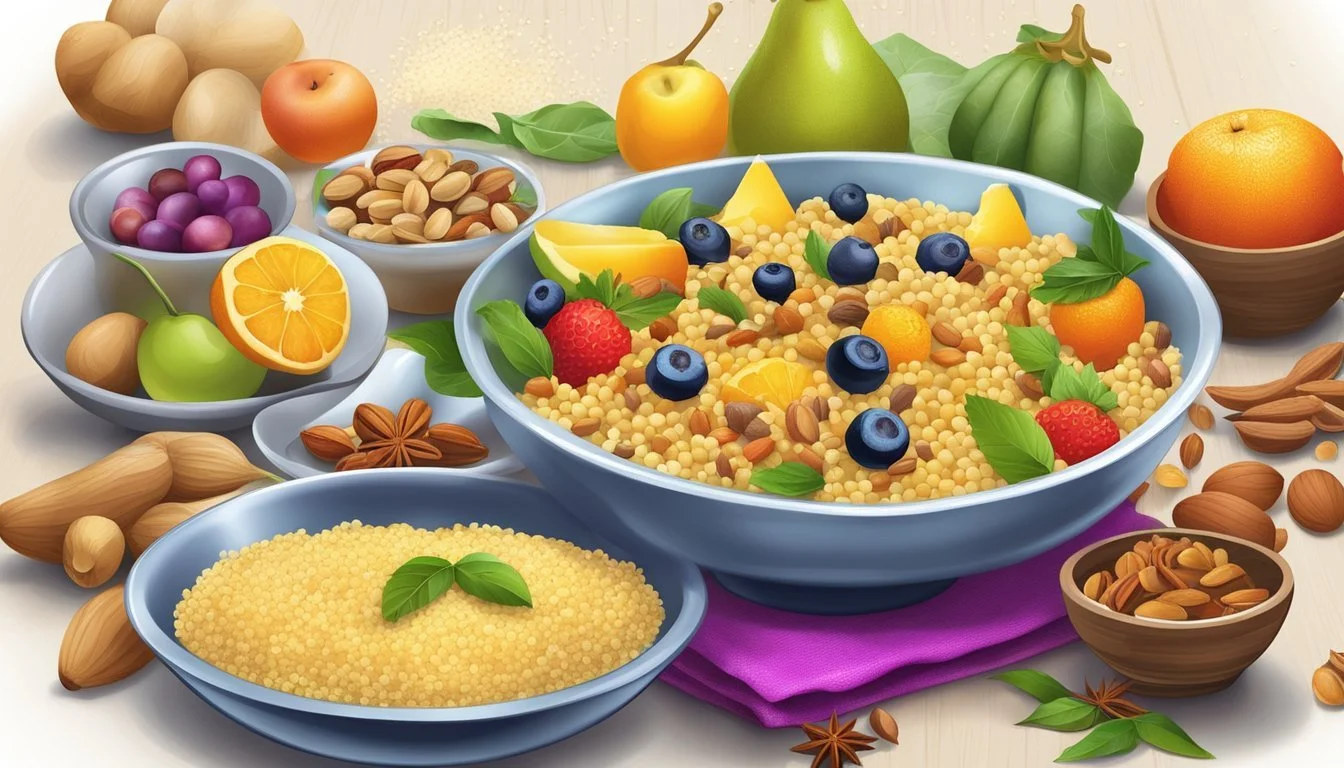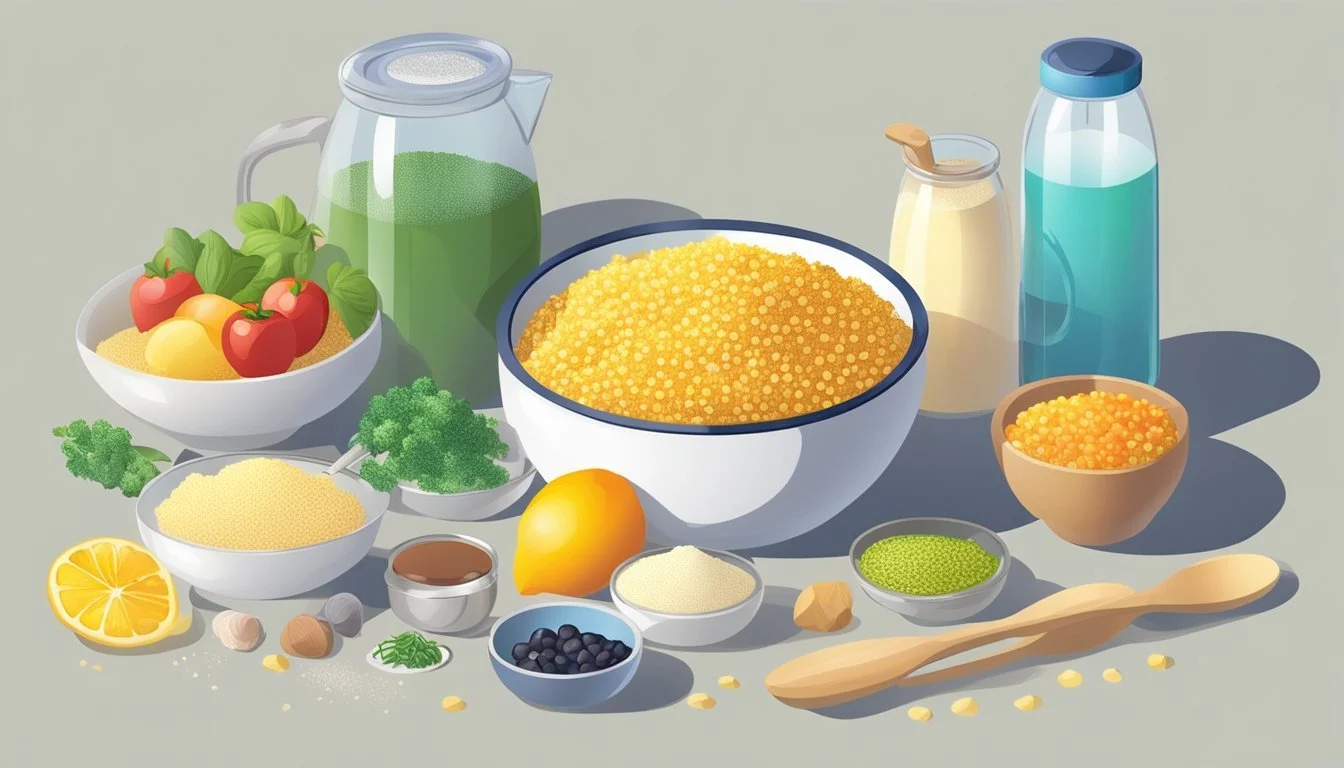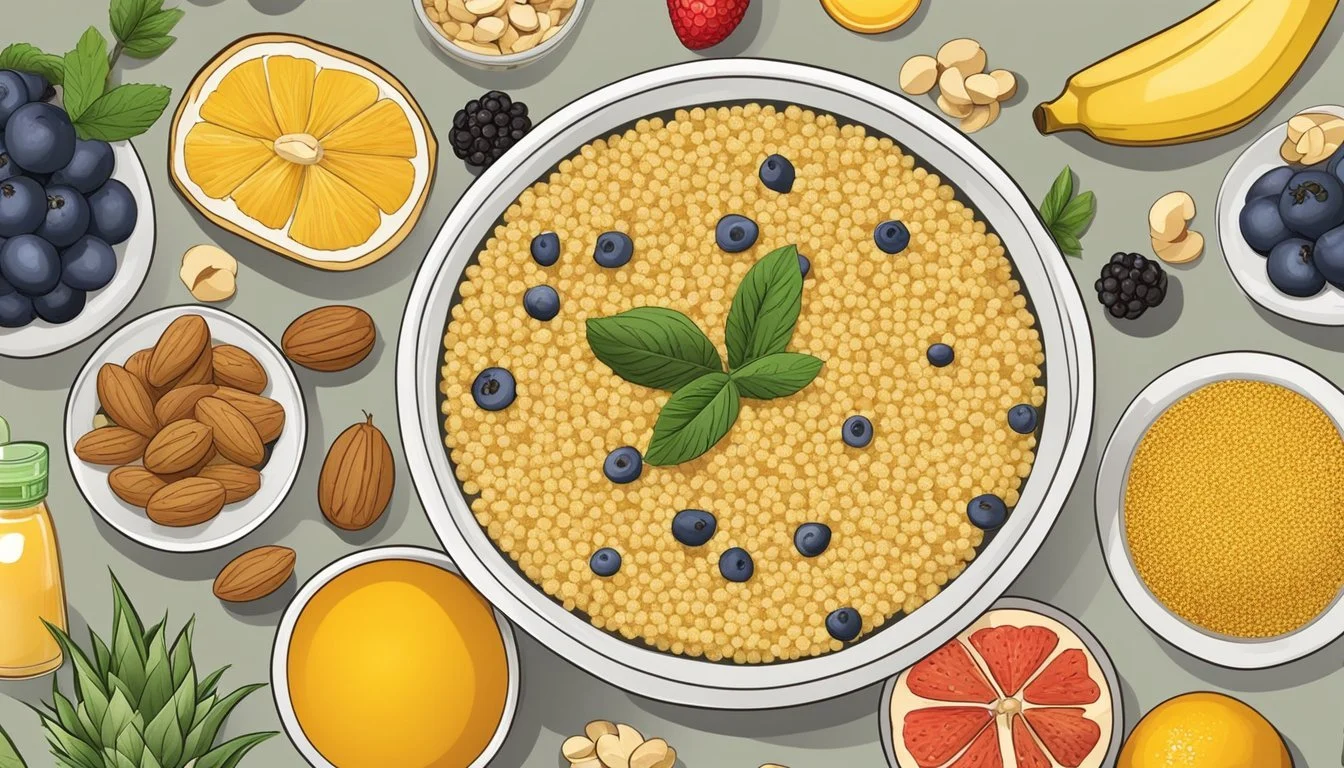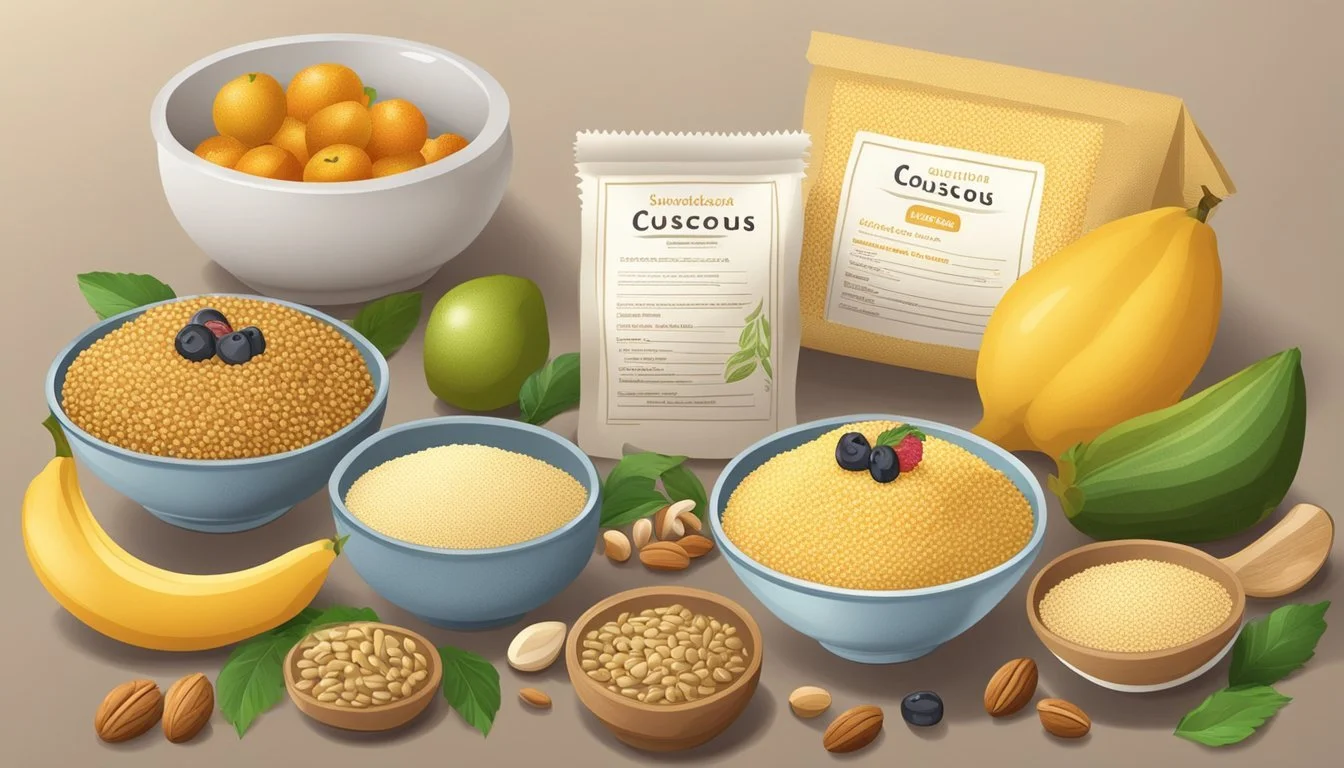Instant Couscous Breakfast Bowls
Quick and Nutritious Morning Recipes
Couscous (What wine goes well with couscous?), the coarsely ground semolina wheat staple that is a traditional dish across the North African regions, has forged its way into breakfast menus for those seeking a quick and healthy start to their day. Easy to prepare and versatile, couscous becomes a nutritious component of an instant breakfast bowl, offering a canvas for a range of flavors and ingredients. As a non-oat alternative, it provides variety to the morning routine, catering not only to those with time constraints but also to health-conscious individuals looking for a fulfilling meal.
The simplicity of preparing couscous is one of its most appealing attributes. With a preparation time that is often less than five minutes, it requires just the addition of boiling water to transform the dried granules into a fluffy base for a breakfast bowl. This expedient process makes it a practical choice for those mornings when time is of the essence.
When it comes to health and nutrition, couscous is a worthy contender on the breakfast table. High in selenium and with a notable amount of protein and dietary fiber, it contributes to a balanced meal that helps to kickstart metabolism and sustain energy levels throughout the morning. It's the perfect foundation for a diverse array of toppings and mix-ins, from fresh fruits and nuts to a drizzle of honey or maple syrup, allowing for an easy customization that fits any palate or dietary preference.
What Is Couscous?
Couscous is a staple food traditionally associated with the Mediterranean and North African cuisine. This versatile dish is made from tiny steamed balls of semolina wheat. Although sometimes mistaken for a grain, couscous is actually a type of pasta.
The preparation of couscous involves rolling semolina wheat with water to form small, rounded granules. It is then steamed until cooked. The result is a fluffy texture that serves as a culinary canvas for a range of flavors and ingredients.
Couscous comes in several varieties, with two popular forms being:
Moroccan Couscous: The smallest type, often used in traditional dishes.
Israeli Couscous (also known as Pearl Couscous): Larger and similar to the size of peppercorns, it has a chewier texture.
In comparison to other whole grain foods like quinoa and millet, couscous cooks quickly, making it a convenient and nutritious option for meals. While couscous is not a whole grain itself, it can be found in whole wheat versions, which offer more fiber and nutrients.
Adjacent to couscous in Mediterranean cuisine is quinoa, a gluten-free whole grain that is a complete protein, and millet, another gluten-free option. Both can be alternatives to couscous for those looking for different health benefits or who have dietary restrictions.
In summary, couscous is a traditional food hailing from the Mediterranean regions, enjoyed for its quick cooking time and adaptability to various flavors, making it a beloved ingredient for breakfast bowls to a dinner side.
Benefits of Couscous for Breakfast
Starting the day with a couscous breakfast provides a nutrient-dense meal that can align with weight management goals while fitting into busy morning routines. Couscous bowls offer a foundation for incorporating proteins, vegetables, and greens to craft a fulfilling breakfast that's ready in minutes.
Nutrient-Rich Start to the Day
Couscous, a form of whole grains, is packed with fiber and protein which are essential for a nutritious start. A bowl of couscous for breakfast can fuel the body with essential nutrients, including B-vitamins and minerals like selenium and magnesium. Adding assorted vegetables and greens increases the nutrient profile, introducing antioxidants and vitamins to the meal.
Fiber: Vital for digestive health and satiety.
Protein: Supports muscle health and energy levels.
Supports Weight Loss Goals
Incorporating couscous into a breakfast routine may help in achieving weight loss objectives. It is a low-calorie option that can be very satisfying, assisting in portion control throughout the day. The protein content aids in maintaining muscle mass during weight loss, and its high fiber content helps in feeling full longer which can reduce overall calorie intake. Pairing couscous with nutrient-dense, low-calorie vegetables can further enhance its benefits for weight loss.
High fiber: Helps in feeling full, reducing the likelihood of overeating.
Low calorie density: Allows for a larger portion that is lower in calories compared to other grains.
Quick and Convenient
The ease of preparing couscous makes it an ideal choice for breakfast. With a total prep time often under 20 minutes, it becomes an efficient way to ensure a healthy, custom breakfast that is ready in a flash. It can be prepared with boiling water or milk and left to stand for about 5 to 10 minutes. This quick turnaround makes it a convenient addition to any morning routine.
Total time: About 15 minutes from prep to plate.
Convenient: Easy to scale up for meal-prepping or for feeding a family.
Essential Ingredients and Substitutions
When preparing Instant Couscous Breakfast Bowls, selecting the right ingredients and knowing suitable substitutions is essential for a nutritious and flavorful meal.
Choosing the Right Type of Couscous
Couscous comes in various sizes, each offering a different texture and cooking time. Israeli couscous, also known as pearl couscous, is larger in size and offers a chewier texture, making it a hearty base for a breakfast bowl. When unavailable, one can substitute with whole grain couscous for added fiber or gluten-free alternatives such as quinoa or millet for those with dietary restrictions.
Protein Additions for a Filling Meal
To make couscous bowls more satiating, chickpeas, lentils, nuts, and seeds are excellent protein options, catering to both vegan and vegetarian diets. For non-vegetarian meals, adding eggs or Greek yogurt can provide an extra protein boost. These ingredients not only add substance but also contribute to the dish's nutritional profile.
Vegetables and Greens
Vegetables are a staple in breakfast bowls for their nutrients and freshness. Common additions include diced tomatoes, cucumber, spinach, and bell pepper. These can be easily swapped with any seasonal vegetables on hand to maintain a balance of color and texture. Greens such as arugula or kale can be used instead of spinach for a peppery bite.
Flavor Enhancers
To elevate the taste, incorporation of olive oil, salt, and pepper is a standard practice. Additional flavor can be introduced through spices like cumin, herbs like cilantro, parsley, and mint, or a squeeze of fresh lemon juice. If fresh herbs are not available, dried alternatives can be used in reduced amounts due to their concentrated flavor.
Step-by-Step Instant Couscous Preparation
Preparing a couscous breakfast bowl in an Instant Pot is a quick and convenient way to start the day. The following steps are designed to be simple and efficient, yielding a delicious meal with a variety of options to cater to different dietary needs.
Cooking Couscous
Measure: For a single serving, one cup of couscous will suffice. Proper measurement ensures ideal water-to-couscous ratio.
Water: Add an equal ratio of water to couscous into the Instant Pot; for one cup of couscous, use one cup of water.
Texture: Secure the lid on the Instant Pot and set to cook at low pressure for one minute. This short duration is sufficient as couscous cooks quickly.
Fluffy Finish: After cooking, use a fork to fluff the couscous, creating a light and airy texture essential for a pleasant mouthfeel.
Assembling Your Breakfast Bowl
Base: Transfer the fluffy couscous into a bowl, forming the base of your breakfast dish.
Fruit & Vegetables: Enhance your bowl with nutritious additions such as chopped tomato, sliced cucumber, or halved cherry tomatoes.
Extra Richness: For a creamy texture, consider adding slices of avocado.
Serve Hot: It's preferable to serve the couscous bowl immediately, while it's still warm, to enjoy its hearty texture.
Variations for Every Diet
Vegan:
Skip animal-based products, opting for plant-based toppings like sautéed spinach or mushrooms.
Use water or vegetable broth to cook couscous instead of dairy-based liquids.
Gluten-Free:
Ensure the couscous label specifies it's gluten-free, suitable for people with sensitivities or celiac disease.
Vegetarian:
Top with veggie-friendly proteins such as chickpeas or soft-boiled eggs for added sustenance.
Mediterranean Diet:
Stick to whole, fresh produce and include a drizzle of olive oil for authenticity.
Experiment with sweet or savory flavors and spices to fit these variations to your taste and dietary choices.
Serving and Pairing Suggestions
Instant couscous breakfast bowls offer a delectable and quick option for a morning meal, blending well with a variety of pairings to cater to both sweet and savory preferences. The key to an enjoyable couscous breakfast lies in choosing the right side dishes and beverages that complement the flavors and textures.
Complementary Side Dishes
For those who gravitate towards sweet indulgences in the morning, a couscous breakfast bowl harmonizes beautifully with fruit-based sides. Here are a few specific options:
Mediterranean Couscous Salad: Toss couscous with diced tomatoes, cucumbers, and red onions. Add generous amounts of mint and a squeeze of lemon juice for a refreshing side.
Honey-Roasted Vegetables: (What wine goes well with roasted vegetables?) Easily prepared by drizzling vegetables with honey and a drizzle of olive oil before roasting, they make for a delightful savory companion to couscous.
Incorporating these sides not only enhances the main dish but also ensures a balanced and full-flavored breakfast experience.
Drinks to Enhance the Experience
Choosing the right beverage can elevate the couscous bowl experience. Here’s what one might consider serving:
Herbal Tea: A mint or chamomile tea can accent the lightness of a savory couscous bowl.
Freshly Squeezed Orange Juice: The acidity and sweetness can complement both sweet and savory couscous options, offering a vibrant start to the morning.
Pairing these drinks with the couscous bowl creates a well-rounded breakfast with varied flavors, textures, and aromas.
Storage and Reheating Tips
When enjoying Instant Couscous Breakfast Bowls, preserving the freshness of leftovers is crucial, and reheating them properly can make your meal feel freshly made. Below are specific guidelines for storage and reheating that ensure the breakfast bowl retains its desirable taste and texture.
Preserving Leftovers
Storage:
After the meal, transfer the leftover couscous breakfast bowl to an airtight container.
Place it in the fridge, where it can keep for up to 4 days.
Preventing Sogginess:
To ensure the couscous doesn't become soggy, separate it from any sauce or wet ingredients before storing.
Meal Prep:
Consider meal prepping your couscous in separate portions to make reheating more convenient.
Best Ways to Reheat
Microwave:
For a quick reheat, use the microwave. Place the couscous in a microwave-safe bowl.
Add a tablespoon of water to prevent drying out.
Cover with a vented lid and heat on high for 1-2 minutes, stirring halfway through the process.
Stovetop:
For a crisped texture, use the stovetop.
Preheat a skillet over medium heat. Add a small amount of oil or butter to prevent sticking.
Add couscous and heat for 2-3 minutes or until thoroughly warm, stirring frequently.
By following these storage and reheating tips, one will enjoy their couscous meal as if it were just made, honoring the dish’s flavors and textures every time.
Garnishes and Toppings for Added Flavor
The right garnishes and toppings can transform a basic couscous breakfast bowl into a flavorful and nutritious meal. Below are specific suggestions for fresh herbs and spices, as well as nuts, seeds, and fruits to enhance the taste and texture of your breakfast bowl.
Fresh Herbs and Spices
Incorporating fresh herbs can significantly elevate the flavor profile of couscous. A sprinkle of chopped parsley or cilantro provides a vibrant, fresh taste, while a hint of mint adds a refreshing twist. For a zestier kick, a squeeze of lemon juice works wonders, especially when complemented by a touch of cumin for earthy warmth.
Parsley: Bright and clean flavor
Cilantro: Strong, citrusy profile
Mint: Cool and refreshing
Lemon juice: Adds zing and vibrancy
Cumin: Warm, smoky undertones
Nuts, Seeds, and Fruits
A combination of nuts and fruits can introduce delightful textures and tastes. Almonds, whether slivered or chopped, add a satisfying crunch and nutty undertones. Pairing couscous with fruit can add natural sweetness; diced banana or a scattering of dates work beautifully. For a finishing touch, a dusting of cinnamon contributes a subtle warmth and spice.
Almonds: Nutty flavor and crunchy texture
Banana: Provides natural sweetness
Dates: Chewy and rich with a caramel-like flavor
Cinnamon: A sweet and woody spice
Customizing Your Bowl
Instant couscous breakfast bowls are versatile, offering a wide range of flavor profiles and dietary accommodations. Whether one prefers a burst of sweetness to start their day or a hearty savory meal, couscous provides a perfect blank canvas.
Sweet vs. Savory Flavors
For sweet bowls, couscous pairs well with fruits like bananas and strawberries. Drizzling honey or maple syrup adds a natural sweetness that complements the neutral taste of couscous. Cinnamon can be sprinkled on top for a warming spice note.
In contrast, savory breakfast bowls utilize spices and hearty add-ons. Couscous can be mixed with olive oil, salt, and pepper, and topped with ingredients like roasted vegetables or a poached egg. Additional seasonings such as paprika or onion powder can enhance the savory experience.
Diet-Specific Adjustments
For those on a gluten-free diet, it’s crucial to ensure that the couscous is labeled as gluten-free, since traditional couscous is a wheat product.
Vegan and plant-based diners can enjoy couscous by substituting honey with maple syrup and using plant-based toppings like avocado or sautéed spinach. Nutritional yeast can also be sprinkled on top to add a cheese-like flavor.
By selecting suitable flavorings and toppings, anyone can tailor their instant couscous bowl to fit within their dietary preferences while enjoying a satisfying, nutritious breakfast.
Nutrition Facts and Health Impact
Instant couscous breakfast bowls offer a nutritious start to the day, with a composition that includes protein, fiber, and essential vitamins and minerals. As a derivative of wheat, couscous is a type of whole grain, which can be a beneficial part of a balanced diet.
Protein and Fiber: Couscous contains a modest amount of protein, which is vital for muscle repair and growth. Its fiber content aids in digestion and promotes a feeling of fullness, helping to control appetite and support weight management.
Nutrient Amount per serving Protein Variable Fiber Variable
Nutrients: This dish is rich in B vitamins such as niacin, thiamin, vitamin B5, vitamin B6, and folate—all of which play crucial roles in energy metabolism and the maintenance of proper bodily function. Minerals like manganese, phosphorus, copper, magnesium, iron, zinc, calcium, and potassium found in couscous are integral to bone health, immune function, and more.
A single serving can contain:
Niacin (6 mg)
Vitamin B5 (0.6 mg)
Thiamin (0.3 mg)
Manganese (1.3 mg)
Phosphorus (294 mg)
Magnesium (76 mg)
Whole Grains: Whole wheat couscous is a preferred choice for health-conscious individuals, as it retains more natural nutrients and fiber compared to refined versions. It contributes to cardiovascular health and can be part of a diet that aims to prevent chronic diseases.
Instant couscous bowls are convenient and adaptable, allowing for the addition of various fruits, nuts, and seeds to enhance both nutritional value and taste. These additions can further increase the content of protein and fiber, as well as provide healthy fats and antioxidants.
Interactive Community and Feedback
The "Interactive Community and Feedback" section provides avenues for enthusiasts to engage with others who share a passion for instant couscous breakfast bowls. Readers are encouraged to share their culinary creations and address queries or concerns through a structured feedback mechanism.
Share Your Creations
They can utilize social media platforms such as Instagram to post photos or videos of their breakfast bowls. By using relevant hashtags, for example, #CouscousBreakfastBowl, they become part of a larger community conversation. Community members can then view these posts, leaving a rating or comment to provide their feedback or simply to show their appreciation for the shared content.
FAQs and Common Concerns
A structured FAQ section can effectively address frequent questions and common concerns related to instant couscous breakfast bowls. Below is a table outlining common queries:
Frequently Asked Questions (FAQs) Community Responses How long should couscous be soaked? Typically, 5-10 minutes with boiling water. What are the best toppings for a breakfast bowl? Popular options include fruits like bananas and strawberries, or savory toppings like roasted garlic or olive oil. How can I store leftover couscous? Couscous can be stored in an airtight container in the fridge for up to a week.
Community members can leave a comment under the FAQ section to share their experiences or to seek further clarification. The feedback and queries received in the comment section can be used to regularly update the FAQ content, ensuring it remains current and practical.
Conclusion
Instant Couscous Breakfast Bowls offer a delightful balance of convenience and nutrition. These dishes exemplify a simple, yet fulfilling way to begin the day. They incorporate couscous, a versatile grain renowned for its quick cooking time.
Ease of Preparation: One of the standout qualities of couscous is its ease of preparation. It requires only boiling water, which can then be poured over the grain, left to sit covered for a few minutes, and voilà—a fluffy base ready to be tailored with various toppings.
Nutritional Value: When considering nutrition, couscous brings a good source of energy through carbohydrates. It can also contribute to one's dietary fiber intake. By adding fruits, nuts, or a drizzle of honey, the nutritional profile is enhanced, offering a combination of vitamins, minerals, and antioxidants.
Recipe Variability: The adaptability of the couscous breakfast bowl allows for numerous delicious variations. One can enjoy it with sweet accompaniments such as bananas and strawberries or savory options like roasted garlic or olive oil. Each ingredient chosen adds a unique profile to the final dish.
In summary, an Instant Couscous Breakfast Bowl is an excellent choice for those seeking a meal that is both easy to prepare and nutritious. It caters to diverse palates and dietary preferences, affirming its place as a staple for a quick and hearty meal to jump-start the day.












